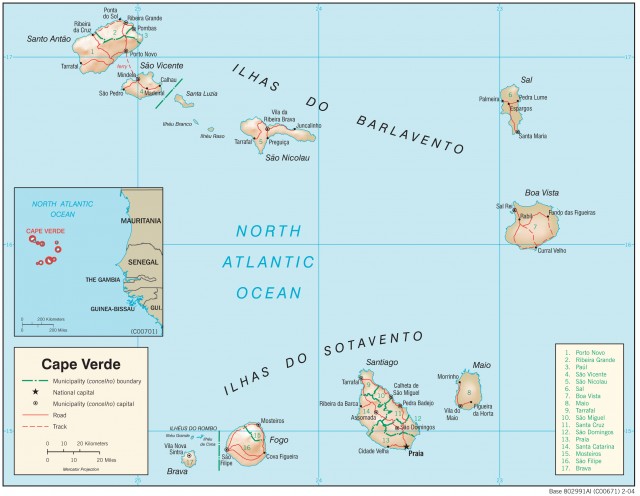Cape Verde
The nation of Cape Verde (also known as Cabo Verde) consists of 15 islands about 400 miles off the coast of SENEGAL. Although the name means “Green Cape,” the islands actually have a hot, dry climate and very little arable land. The capital city of Praia is on the island of Santiago Before its discovery by the Portuguese in 1460, Cape Verde was uninhabited. Portugal used the islands as a supply base for slave ships making the voyage from Africa to America. The islands eventually became home to descendants of African slaves and European settlers from Portugal and the Mediterranean. The Portuguese often chose Cape Verdeans to administer their other African colonies; many served overseas.
During the late 1950s, Cape Verde joined GUINEA-BISSAU in seeking independence from Portugal. By 1975 both colonies had won their independence, and for the next five years one political party, the PAIGC, governed both countries. Aristides Pereira became the first president of Cape Verde. The nation planned to unite with Guinea-Bissau, but a 1980 coup in Guinea-Bissau altered the course of events. The Cape Verde PAIGC changed its name to the PAICV and declared itself the country's only legal party.

Cape Verde's government has been remarkably stable since independence, with only a single unsuccessful coup attempt in 1977. In 1990 opposition political groups formed the Movement for Democracy (MPD) and pressured the government to end single-party rule. Multiparty elections were held in 1991, and Antonio Mascarenhas Monteiro of the MPD was elected president.
The population of Cape Verde, about 400,000, is ethnically homogenous. Almost all the people are Catholic and speak Crioulu, a Portuguese-African language. In culture, Cape Verdeans are closer to the Portuguese than to West Africans.
With little rainfall, the islands produce only enough food to supply about 10 percent of the needs of the people. Drought and famine are common occurrences. Nevertheless, the majority of the people work in agriculture. Much of the land is held by landlords who hire laborers to work their fields. Most farms are very small, typically less than three acres in size.
For many years, a large number of men have emigrated to find work overseas. Many have worked in the cod fishing industry in the north Atlantic ocean and have settled in southeastern New England. In fact, twice as many Cape Verdeans live outside the country as live on the islands. These emigrants send millions of dollars home each year, contributing a large percentage of the country's foreign earnings. Because so many men have left the islands, the adult population is about 55 percent female, and women head almost 40 percent of all households. (See also Colonialism in Africa, Slave Trade.)